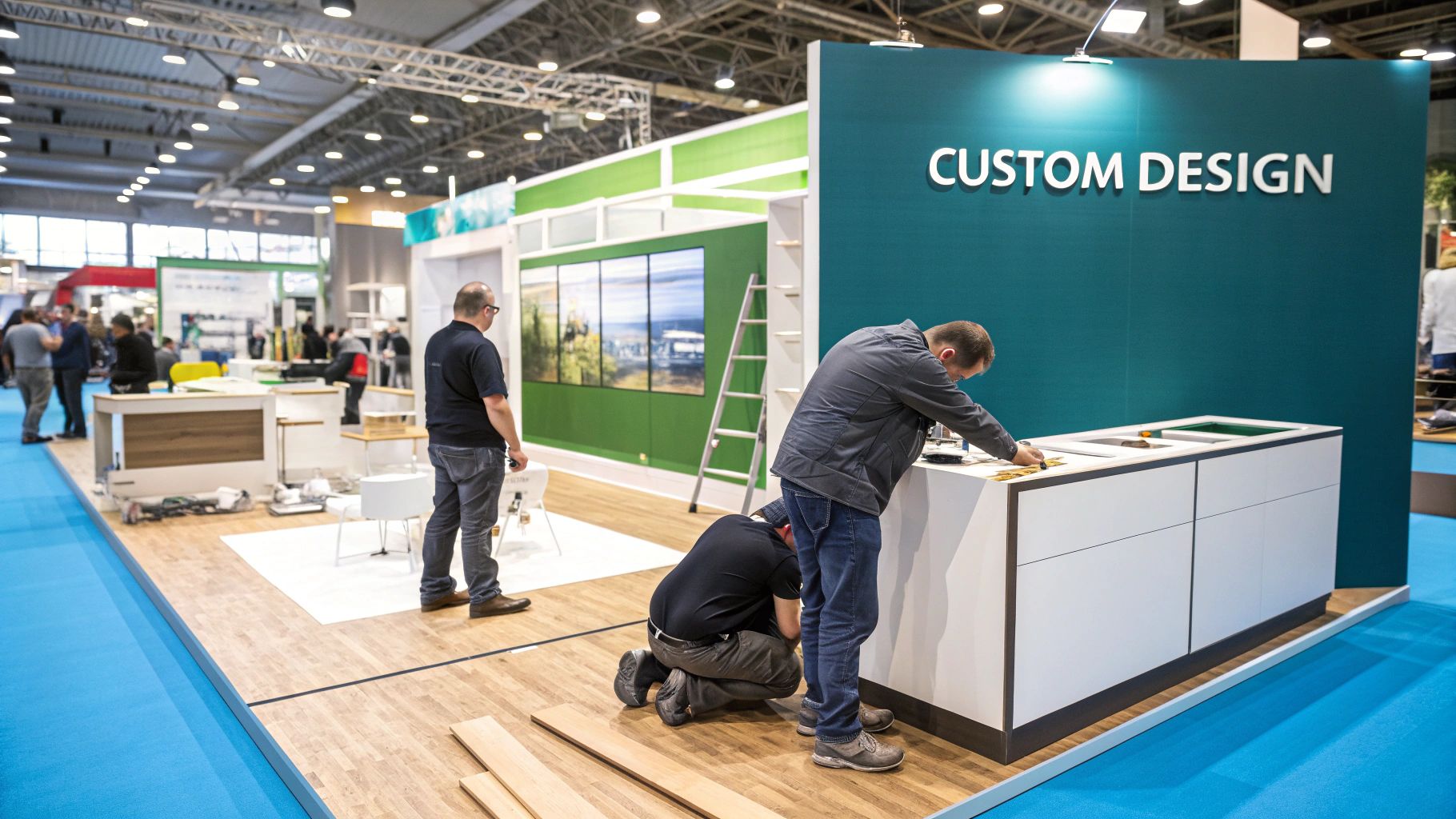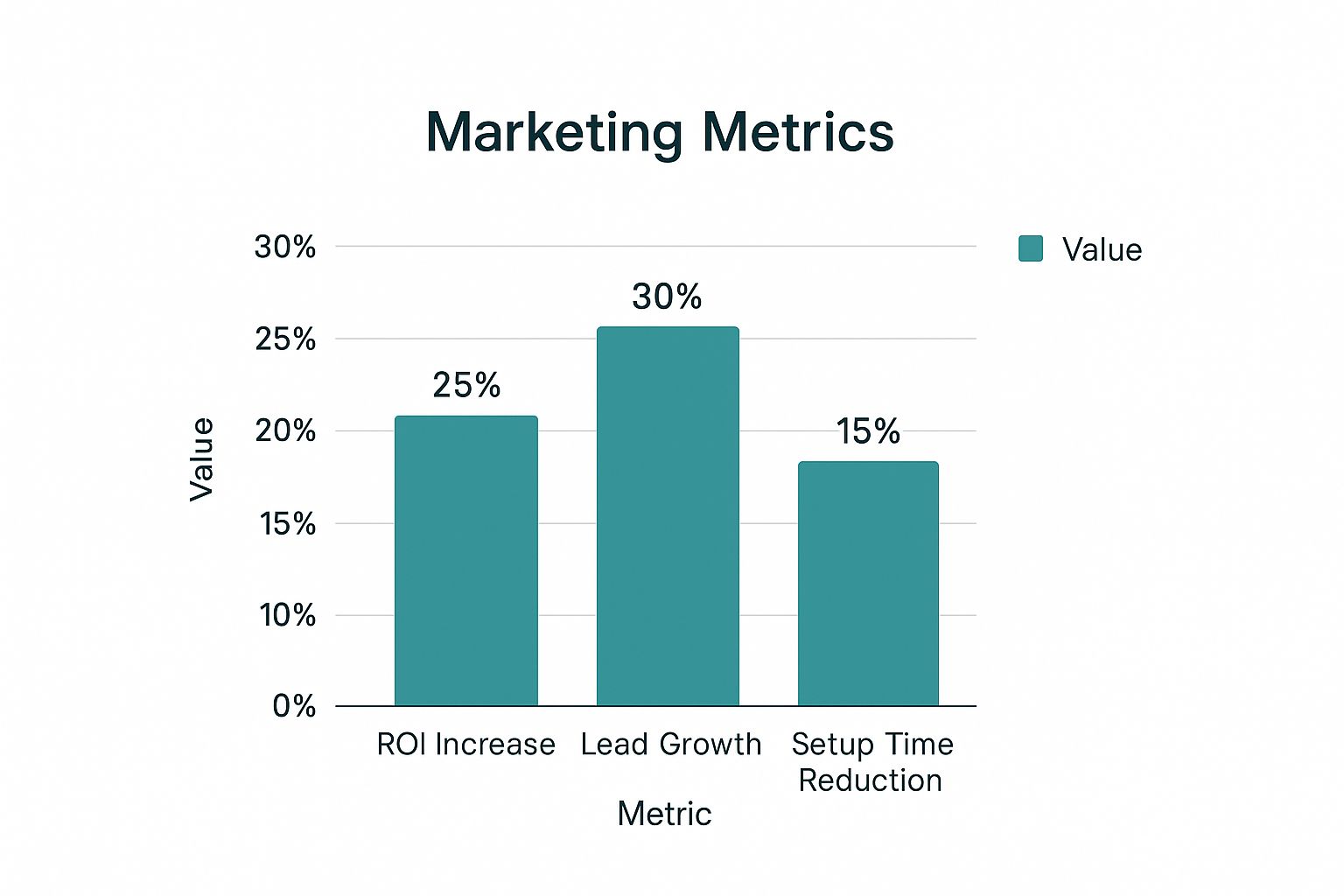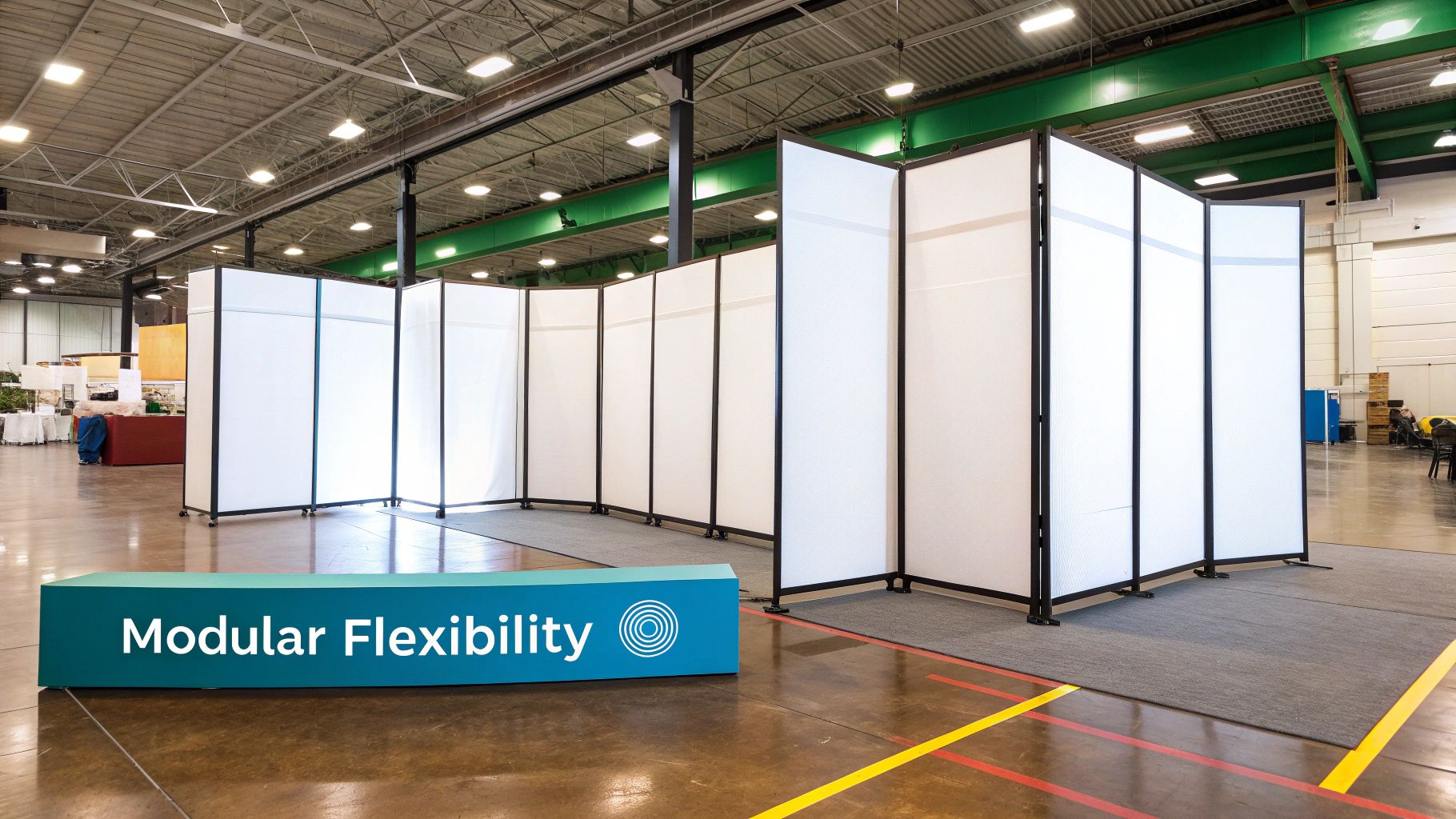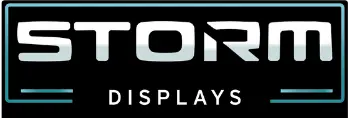You've got a critical trade show on the horizon. Do you play it safe with a generic, off-the-shelf display, or do you invest in a space that truly embodies your brand? A custom trade show exhibit is a powerful strategic tool, built from the ground up to tell your story, engage your ideal customer, and achieve specific business goals. Unlike rental kits, going custom gives you complete control over the layout, materials, and technology, resulting in a one-of-a-kind experience that stops attendees in their tracks.
But where do you begin? This guide will walk you through the essential steps, from aligning the design with your business goals to managing the complex logistics of getting your booth from blueprint to the show floor.
Aligning Your Exhibit with Business Goals

Before a single sketch is drawn, the most important work happens: defining your purpose. What does a successful outcome look like for your company at this specific event? A truly effective custom exhibit isn't just an attractive structure; it's a strategic environment engineered to hit specific, measurable targets. Your company's mission needs to be translated into a physical experience that communicates your value proposition without a single word. This means getting crystal clear on your objectives first.
Defining Your Primary Objectives
What is the core mission for this show? Are you aiming to fill your sales pipeline with qualified leads for a new service offering? Perhaps the primary goal is to launch a new product with maximum impact and media buzz. Or maybe your objective is to solidify your position as the undisputed industry leader.
Each of these goals demands a completely different design and functional approach for your trade show exhibits custom build.
- Lead Generation: Your design should prioritize features like semi-private meeting areas, interactive demo stations, and a clear traffic flow that guides visitors toward a conversation with your team.
- Product Launch: Think bold. An eye-catching architectural centerpiece, a large open floor plan for demonstrations, and dramatic lighting can create the excitement needed to draw a crowd.
- Brand Dominance: The design should communicate authority and quality. This might involve using premium materials, sophisticated technology, and an architectural style that feels more like a permanent installation than a temporary booth.
Nailing down these goals from the start provides the strategic direction for every subsequent decision. For a deeper dive into turning these goals into a physical reality, getting expert insights on trade show booth design can provide invaluable guidance.
Identifying Your Ideal Attendee
Once you know what you want to achieve, you must define who you need to engage. Picture the exact person you want walking into your booth. What is their job title? What are their biggest professional challenges? What solution are they hoping to discover at this event?
Your booth needs to speak their language and address their pain points. For instance, if you're targeting C-suite executives, a comfortable, exclusive lounge for high-level conversations is far more effective than a loud, flashy game. Conversely, if you're targeting engineers, they will want to interact with your product, making hands-on tech displays and detailed demonstrations essential. This focused approach is what converts casual passersby into genuine prospects.
With the resurgence of in-person events, this strategic groundwork is more critical than ever. Recent data shows that 81% of attendees hold buying authority, and with 46% attending only one show per year, your opportunity to make an impression is limited. These are not casual browsers; they are decision-makers on a mission. A thoughtfully designed custom exhibit is your best tool for capturing their attention and ensuring your investment delivers results.
Building a Realistic Custom Exhibit Budget
Let's discuss the financial side. Crafting a comprehensive budget is where a brilliant custom exhibit concept takes flight or gets grounded. A common mistake, even for experienced marketing managers, is focusing solely on the initial design and fabrication cost. They approve a design they love, only to be surprised by the significant operational costs that follow. A smart budget is the financial blueprint for your entire project, enabling strategic decisions and preventing costly surprises.
The Hidden Costs Behind the Build
The world of custom exhibits comes with its own vocabulary—and its own set of line items. The costs required to transport, install, and operate your booth on the show floor are substantial and non-negotiable.
Here’s what often catches people by surprise:
- Drayage (Material Handling): This is the fee charged by the show's official contractor to move your exhibit crates from the loading dock to your booth space (and back again). It’s calculated by weight, and a heavy, complex custom build can make this one of your largest expenses.
- Installation & Dismantle (I&D) Labor: You need a professional crew to assemble your exhibit and take it down. Labor rates vary by city, and costs can escalate quickly with overtime rates for nights or weekends.
- Shipping: Transporting your exhibit to and from the convention center is a major logistical expense influenced by distance, weight, and your choice of carrier.
- Show Services: This category includes all the essentials: electricity, internet access, rigging for hanging signs, flooring, and lead retrieval devices. Order these early, as at-show prices are significantly higher.
Strategic design choices, such as using lightweight materials, can directly reduce these operational costs and improve your overall return on investment.

A well-engineered custom exhibit is an investment designed to drive a 30% increase in qualified leads and a 25% jump in ROI, partly by reducing operational costs like a 15% reduction in setup time.
Custom Exhibit Budget Allocation Guide
This table provides a typical breakdown of how a custom exhibit budget is allocated. While your specific numbers will vary, this serves as a solid starting point for your financial planning.
| Expense Category | Percentage of Total Budget | Key Considerations |
|---|---|---|
| Exhibit Design & Build | 35-45% | Covers the physical structure, graphics, and custom fabrication. Complexity and materials are the main drivers. |
| Show Services | 20-30% | Includes drayage, I&D labor, electrical, and internet. Drayage is often the largest single item in this category. |
| Space Rental | 15-25% | The cost per square foot for your booth space, which varies dramatically by event and location. |
| Shipping & Logistics | 5-10% | The cost to transport your exhibit. Fuel surcharges and carrier choice heavily impact this. |
| Travel & Staffing | 5-10% | Flights, hotels, and per diems for your booth staff. |
| Contingency Fund | 5-10% | Essential for covering unexpected repairs, last-minute needs, or surprise fees. Never skip this. |
Where to Invest and Where to Save
With a clear understanding of the full cost picture, you can make smarter trade-offs. The goal is to allocate funds where they will have the greatest impact on attendee engagement.
Invest your budget in elements that create memorable "wow" moments and draw people in:
- Dynamic Lighting: Professional lighting is a game-changer. It makes graphics pop, sets the mood, and gives your space a high-end feel.
- High-Resolution Graphics: Your brand message is conveyed through your visuals. Crisp, professionally produced graphics are non-negotiable.
- Interactive Technology: A compelling touchscreen experience, a VR demonstration, or another hands-on element can transform a passive visitor into an engaged lead.
Conversely, you can find significant savings in less visible areas. Using lightweight, modular components can dramatically reduce both shipping and drayage costs. If your budget is tight, don't assume you have to sacrifice your vision. It may be the perfect opportunity to explore rental options. To better understand the financial comparison, see our guide on the trade show booth rental cost and how it stacks up.
From Blueprint to Reality: The Design and Build Journey

This is where strategy becomes tangible. The process of turning your goals and budget into a physical, show-stopping exhibit is a collaborative journey. Selecting the right design and fabrication partner is the single most critical decision you will make. Your exhibit partner acts as a translator for your brand, transforming your marketing objectives into architecture, lighting, and functional spaces that engage your target audience.
From Napkin Sketch to Photorealistic Previews
The design process begins with broad exploration and becomes progressively more detailed. It often starts with concept sketches, allowing for creative brainstorming around different layouts and architectural forms that fit your space and budget.
From there, the process moves to photorealistic 3D renderings. These are not simple mockups; they are incredibly detailed, computer-generated images that show you exactly what your trade show exhibits custom design will look like on the show floor, down to the specific lighting and material textures. This visualization step is essential, as it allows you to virtually "walk" through your booth and assess the traffic flow and overall feel before fabrication begins. It is your best and most cost-effective opportunity to make changes.
Marrying Form and Function
A visually stunning exhibit that is difficult to navigate is a beautiful failure. The most successful booths masterfully blend eye-catching design with real-world practicality. This comes down to considering how attendees will move through and interact with your space.
An open, welcoming layout is crucial for drawing people in from the aisle. Great designs use elements like flooring, lighting, and furniture to subconsciously guide visitors along a specific path. We recommend creating distinct zones for different activities to keep the space organized and ensure every square foot serves a purpose.
- The Welcome Zone: A reception counter or kiosk at the front to greet visitors.
- The Engagement Zone: Dedicated demo stations where attendees can get hands-on with your products.
- The Consultation Zone: Semi-private lounges or meeting rooms for in-depth conversations.
- The Hospitality Zone: A small coffee bar or charging station to encourage attendees to linger.
Weaving in Tech and Finalizing Finishes
Technology should be an integral part of the design, not an afterthought. Whether it's a large-scale LED video wall or interactive touchscreens for self-guided discovery, technology should feel seamlessly integrated into the structure. These elements create immersive, memorable moments that resonate with attendees long after the show.
Simultaneously, you and your design partner will finalize material selections. The finishes you choose—from sleek laminates and sustainable woods to vibrant backlit fabrics and industrial metals—have a massive impact on the look, feel, and durability of your booth. The entire process is deeply collaborative, and your active engagement at each milestone, from the first sketch to the final approval of graphic proofs, is key to ensuring the final product is an exhibit that truly performs.
Conclusion: Take the Next Step
Creating a custom trade show exhibit that captivates your audience and delivers measurable results requires a blend of strategic planning, creative design, and flawless execution. By aligning your exhibit with clear business goals, building a realistic budget, and partnering with an experienced design and fabrication team, you can create a powerful brand experience that sets you apart from the competition.
Ready to build an exhibit that not only stops people in the aisles but also drives real business? The team at Storm Displays is here to guide you through the entire process.
Explore our custom exhibit solutions or contact us today to request a quote and start the conversation.

